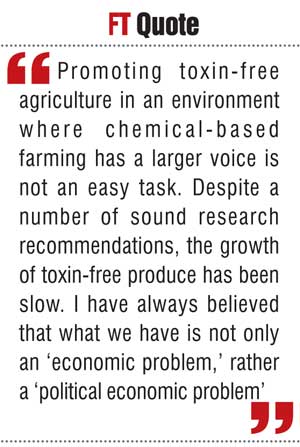Saturday Dec 20, 2025
Saturday Dec 20, 2025
Friday, 23 September 2016 00:01 - - {{hitsCtrl.values.hits}}
The Government is taking a serious interest in toxin-free agriculture
Fertiliser subsidy, research findings for policy makers, 4 January 2015
 This article was based on an empirical study conducted using secondary data. The data was collected from the Department of Agriculture. The empirical analysis looked at the factors contributing to the consumption of chemical fertiliser. Because the fertiliser was heavily subsidised, the analysis looked in to the impact of the subsidy on the fertiliser consumption as well.
This article was based on an empirical study conducted using secondary data. The data was collected from the Department of Agriculture. The empirical analysis looked at the factors contributing to the consumption of chemical fertiliser. Because the fertiliser was heavily subsidised, the analysis looked in to the impact of the subsidy on the fertiliser consumption as well.
The analysis came up with several interesting findings. As the article highlights, the demand for fertiliser decreased  as the price of fertiliser increases. However, the increases are relatively inelastic. Chemical fertilisers do not have close substitutes.
as the price of fertiliser increases. However, the increases are relatively inelastic. Chemical fertilisers do not have close substitutes.
Even though organic fertiliser can be used in place of chemical fertiliser, it is not widely practiced in Sri Lanka and commercial paddy farming is predominantly based on chemical fertilisers. Therefore, simply reducing the fertiliser subsidy would not encourage farmers to adopt organic fertiliser.
Adoption of organic fertiliser in the short run may hinder production unless farmers are compensated for possible yield reductions. Therefore, the objective of promoting organic fertiliser requires farmer support programs to ensure supply of fertiliser.
Price impact on our organic rice farming, 23 July 2015
The article was based on the pricing of organic rice. It discusses the price setting behaviour of farmers and price affordability of consumers. As mentioned in the article the organic rice does not have a controlled price.
On average, the price of a 1kg packet will be between Rs. 150 and Rs. 200. However, the prices differ based on the variety, area of cultivation and other factors. The price difference based on rice varieties is on average Rs. 20 to Rs. 30. The price difference based on area of cultivation is on average Rs. 30 to Rs. 50.
Organic farming practices also vary according to the areas. Farmers in some areas use imported organic fertiliser, which costs around Rs. 3,000 for a 50kg bag, while some only uses livestock manure and green matter as organic manure. The price of organic rice is high in areas where the input cost is high in terms of organic manure.
In some areas the farmers practice organic farming in close association with the religion. Therefore, their cultivation practices are based on auspicious times, or chanting and offerings to gods. In such situations, there’s a high probability of increased rice prices as farmers try to compensate such good practices through pricing.
The article further highlights that it is important to control the price of organic rice and reduce it to a level that can be consumed by all consumers. If not, organic rice will be a luxury commodity produced by large-scale farmers at commercial level, and purchased by upper middle and higher income groups.
Research has shown that urban consumers are willing to pay between Rs. 80 and Rs. 125 for a kilo of organic rice. This is even low among rural consumers. Therefore, a significant price reduction is needed to increase the consumer base for organic rice.
Reducing dependency on fertiliser in paddy farming: Should we change our approach? 18 January
This article is focused on the main component of the toxin free agriculture, the use of organic fertiliser and less pesticides. According to the article it is not ideal to rely on organic fertiliser to reduce chemical fertiliser dependence. It may reduce the chemical fertiliser use in the long run but it will take a national level policy intervention to strongly push the adaption of organic fertiliser in the short and medium terms. The constraints in adapting to organic fertiliser are even visible through the analysis of empirical data.
As the article mentioned, empirical research shows that the increase in labour prices leads to an increase in the use of chemical fertiliser. Therefore, it is essential to increase the level of mechanisation in paddy farming so that less labour is required and chemical fertiliser use will reduce ultimately. However, a majority of paddy farmers in Sri Lanka are small farmers that cultivate average lands of 0.5-2 acres. Therefore, most of these farmers cannot afford large scale machinery, as they simply lack economies of scale.
Highlighted by the article, the next complementary input in paddy farming is pesticides. Intensified pest attacks overtime have made pesticides essential for paddy farming. Farmers regularly apply pesticides to reduce the pests from spreading in a large area of cultivation within a short period.
While application of chemical fertiliser is harmful, the application of pesticides creates far worse health and environmental issues. In the case of excess chemical fertiliser application, the affected parties are basically the consumers. However, the use of excess pesticides will have a direct impact on the farmers who apply the product. The article suggests that the Non Pesticide Management (NPM) is an important way of promoting toxin free produce.
Where is organic farming heading? An economic explanation, 3 August
The article speaks of the opportunity cost in producing organic rice, the willingness to pay for organic rice and ‘The Certification Penalty’ (TCP). As mentioned in the article the opportunity cost of organic farming, compared to inorganic farming comes from labour, seeds and fertiliser. Once the man-days involve in are calculated with wage rates the cost of labour for making the organic fertiliser by them is very high. On average the cost of organic fertiliser would increase by nearly 30% once the own labour is accounted for.
The same issue is with the paddy seed production as well. The time a farmer spent on finding good quality seed will increase the cost of paddy seeds by nearly 20% and the time spent on nursery establishment will raise the cost of paddy seeds by nearly 10%. These time costs are not a significant factor in inorganic farming.
 The article further notes that the consumers are not willing to pay more for organic rice. Income constrains is a major reason but that is not applicable only to organic rice. A consumer would pay a higher price if he/she really believes organic rice is good for certain NCDs. A consumer would also pay a higher price if he believes that organic farming is good for the environment.
The article further notes that the consumers are not willing to pay more for organic rice. Income constrains is a major reason but that is not applicable only to organic rice. A consumer would pay a higher price if he/she really believes organic rice is good for certain NCDs. A consumer would also pay a higher price if he believes that organic farming is good for the environment.
There is enough research being done to justify both these benefits of organic rice. Then the question is, ‘How organic is organic’. Since there is no clear certification system available to show that organic rice is really organic, a consumer has no other market signal other than his peer recommendations and his own trust.
As the article highlights the main reason for a consumer to state a low willingness to pay value is that the incentives are not enough for a consumer to pay a higher price. Cost of certification are high hence farmers depend on the trust and recommendations.
Therefore farmers will not invest in certifications. Realising this, the consumers will only be willing to pay less. The industry will only target a niche market. Hence the organic rice industry will hardly realise its potential. I call this ‘The Certification Penalty’ (TCP).
Believe me I am genuine: Economics of Trust, 26 May
This article is based on the economies of trust, focusing on the issue of certification for organic produce. In the writing, there is an economic explanation to the issue of trust, people’s way of getting around the issue and the right way to address the issue.
As highlighted in the article an organic produce is expensive because it reflects the opportunity cost of production. A producer has to invest more in producing a quality product that generate health benefits or prevent negative health and environmental externalities.
The price premium, the difference between the organic and the non-organic produce reflects the above mentioned opportunity cost. A consumer would pay this price premium as long as he/she trusts that the produce is genuine. A producer uses a market signal to attract the consumer and that is the “certification”.
The article points out that the trust is mainly created through recommendations. For example a doctor prescribing a certain brand or a farmer of organic rice would persuades the consumer to trust that producer. At the same time, a close friend, a relative could also provide the necessary recommendation. Since almost all of these small-scale organic producers do not spend money on certifications, details about them are being disseminated through word of mouth.
Another popular belief is that the large commercial producers are not genuine and small-scale producers are mostly genuine. The article talks about several other ways of establishing trust.
As highlighted in the article the trial and error method is also important in establishing trust. For example, the popular belief is that a rice variety such as Suwandal has a pleasing aroma when being cooked. Farmers who grow these varieties organically claim that the aroma would not be there if chemicals are being used.
Another popular belief is that organically produce rice once cooked would stand a significantly longer time without being spoiled. Therefore, consumers who are exposed to such information would look for these qualities in rice. The producer will be labelled as fake if the product does not hold these qualities.
Another approach that small-scale producers do in place of certification is to conglomerate. For example, small-scale rice producers can form a larger farmer group. These farmer groups work closely with the Department of Agrarian Services. In selling their produce as “organic”, farmers use their connections and associations with the Government institution hoping that people would value them in establishing trust for their products.
Summary
The articles discussed above highlight several important concepts with respect to organic farming. If organic produce or the toxin free produce to be promoted, it is important to understand the factors that determine demand for “the inorganic fertiliser”.
Subsides are only short-term solutions. Though subsidies could do well in promoting toxin free produce, it is important to understand where the subsidy is required. For that as explained by the articles, it is important to understand the “opportunity cost of producing toxin free produce”.
As highlighted by the articles the other most important aspect of organic and toxin free production is the “price” and the “authenticity”. It is important that organic and toxin free produce is affordable to an average consumer and the produce is trustworthy.
Finally, the articles show that application of chemical fertiliser would only be reduced in the long run with proper infrastructure development for organic fertiliser. Hence in the short run the focus should be on “recommended fertiliser” with zero pesticides or Non Pesticide Management (NPM).
(Chatura Rodrigo, PhD is an economist interested in agriculture and environment. He can be reached at [email protected] and +94779867007.)